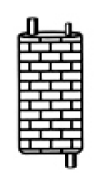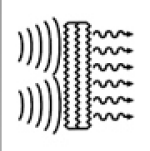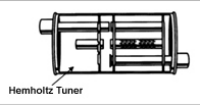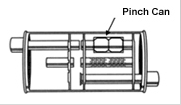Sound Level
There are three basic approaches to controlling noise:

CONTAINMENT
Containment reduces the transmission of sound waves by confining them. Almost any material can help contain sound; the denser it is, the better it works. Many economy mufflers silence exhaust noise by containing the flow of exhaust gases. This is typically not desirable. When exhaust gases are contained, the backpressure increases and vehicle power, performance and fuel economy suffer.

ABSORPTIVE DEVICES
Absorptive devices convert sound energy to heat energy. Sound waves collide with material that flexes and vibrates easily. The material absorbs the sound rather than passing it on as resonance, or bouncing it back toward the source. Sound is reduced by a loss of energy when the absorptive material is moved. This device is more effective on high frequencies. Glasspack-type or glass-filled mufflers are an example of sound reduction by absorptive control.

REACTIVE DEVICES
Reactive devices reduce, change, or eliminate noise by reflecting sound waves back toward the source. One common application of a reactive sound device is the louvered tubes found on the inside of most mufflers. The main purpose of these tubes is to steer sound waves against each other and to use their energy to cancel each other out.

There is one variation of reactive sound control that provides us with a device that reduces low frequency exhaust noise, the Helmholtz tuner. The Helmholtz tuner operates on the theory that when sound waves pulse through a constricted area into a large closed area, the sound energy will be reduced. This action causes a reduction in the low frequency noise of the exhaust gas pulsations.
In a muffler, the Helmholtz tuner is the large empty "chamber" that typically does not have an outlet. This "room" is there to reduce the low frequency noise from the exhaust system.

Another example of a reactive device used to control sound is called a pinch can. This device works on a theory that is the opposite of the Helmholtz tuner theory. A pinch can takes sound waves and forces them into a confined area. As the sound pulsation is exposed to the restricted area, the pressure level of the pulsation decreases. This act of "pinching down" the sound energy serves to eliminate high frequency noise from the exhaust. Most mufflers utilize some type of pinch can within the muffler.
Learn more about quality exhaust parts, find the right car part, or find a local repair shop today.
The content contained in this article is for informational purposes only and should not be used in lieu of seeking professional advice from a certified technician or mechanic. We encourage you to consult with a certified technician or mechanic if you have specific questions or concerns relating to any of the topics covered herein. Under no circumstances will we be liable for any loss or damage caused by your reliance on any content.